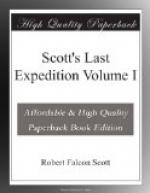Saturday, July 29, Sunday, July 30.—Two quiet days, temperature low in the minus thirties—an occasional rush of wind lasting for but a few minutes.
One of our best sledge dogs, ‘Julick,’ has disappeared. I’m afraid he’s been set on by the others at some distant spot and we shall see nothing more but his stiffened carcass when the light returns. Meares thinks the others would not have attacked him and imagines he has fallen into the water in some seal hole or crack. In either case I’m afraid we must be resigned to another loss. It’s an awful nuisance.
Gran went to C. Royds to-day. I asked him to report on the open water, and so he went on past the Cape. As far as I can gather he got half-way to C. Bird before he came to thin ice; for at least 5 or 6 miles past C. Royds the ice is old and covered with wind-swept snow. This is very unexpected. In the Discovery first year the ice continually broke back to the Glacier Tongue: in the second year it must have gone out to C. Royds very early in the spring if it did not go out in the winter, and in the Nimrod year it was rarely fast beyond C. Royds. It is very strange, especially as this has been the windiest year recorded so far. Simpson says the average has exceeded 20 m.p.h. since the instruments were set up, and this figure has for comparison 9 and 12 m.p.h. for the two Discovery years. There remains a possibility that we have chosen an especially wind-swept spot for our station. Yet I can scarcely believe that there is generally more wind here than at Hut Point.
I was out for two hours this morning—it was amazingly pleasant to be able to see the inequalities of one’s path, and the familiar landmarks bathed in violet light. An hour after noon the northern sky was intensely red.
Monday, July 31.—It was overcast to-day and the light not quite so good, but this is the last day of another month, and August means the sun.
One begins to wonder what the Crozier Party is doing. It has been away five weeks.
The ponies are getting buckish. Chinaman squeals and kicks in the stable, Nobby kicks without squealing, but with even more purpose—last night he knocked down a part of his stall. The noise of these animals is rather trying at night—one imagines all sorts of dreadful things happening, but when the watchman visits the stables its occupants blink at him with a sleepy air as though the disturbance could not possibly have been there!
There was a glorious northern sky to-day; the horizon was clear and the flood of red light illuminated the under side of the broken stratus cloud above, producing very beautiful bands of violet light. Simpson predicts a blizzard within twenty-four hours—we are interested to watch results.
Tuesday, August 1.—The month has opened with a very beautiful day. This morning I took a circuitous walk over our land ‘estate,’ winding to and fro in gulleys filled with smooth ice patches or loose sandy soil, with a twofold object. I thought I might find the remains of poor Julick—in this I was unsuccessful; but I wished further to test our new crampons, and with these I am immensely pleased—they possess every virtue in a footwear designed for marching over smooth ice—lightness, warmth, comfort, and ease in the putting on and off.




